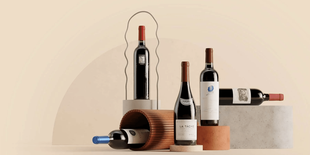Vinovest Quarterly Report - Q4 2023
Further reading
In case you wish to read back to Vinovest Quarterly Report - Q3 2023.
Talk about finishing on a high note. Vinovest portfolios closed the year with a positive fourth quarter. Meanwhile, whiskey casks returned 20% in their first year. Plus, Vinovest debuted whiskey lots, starting at $300. We’ll cover all of that and more in this edition of the Vinovest quarterly report.
By the Numbers
$300 - The new minimum deposit for whiskey investing
23.3% - The average increase in value for 1-year whiskey casks at Vinovest based on December price valuations
1.3% - The average return for wines in Vinovest portfolios in Q4
-3.8% - The return of the Liv-ex 1000 in Q4
-14.1% - The return of the Liv-ex 1000 in 2023, its largest drop since 2011
$2.7 million - The price of a 1926 bottle of The Macallan sold in November, an auction world record for any bottle of wine or spirits
Fine Wine and Whiskey Performance in Q4
Wine Performance
Fine wine closed 2023 with a flourish in what has otherwise been a challenging year. The average Vinovest portfolio saw prices jump 1.3%, the best quarterly performance since Q4 2022. Vinovest portfolios also outpaced the -3.8% return of the Liv-ex 1000, an index that tracks 1,000 of the most investment-worthy wines.

Rest of the World wines proved the most buoyant region at year’s end. The Liv-ex Rest of the World 60 - an index containing ten of the most recent physical vintages of Dominus, Opus One, Screaming Eagle, Vega Sicilia Unico, Seña, and Penfolds Grange - has risen in value twice in the last three months.
Californian wines also represented a key source of that stability. Trade value for Californian wines has been its highest since March 2023. The uptick reflects the region’s consistent quality and reputation, highly desirable traits during periods of economic uncertainty.
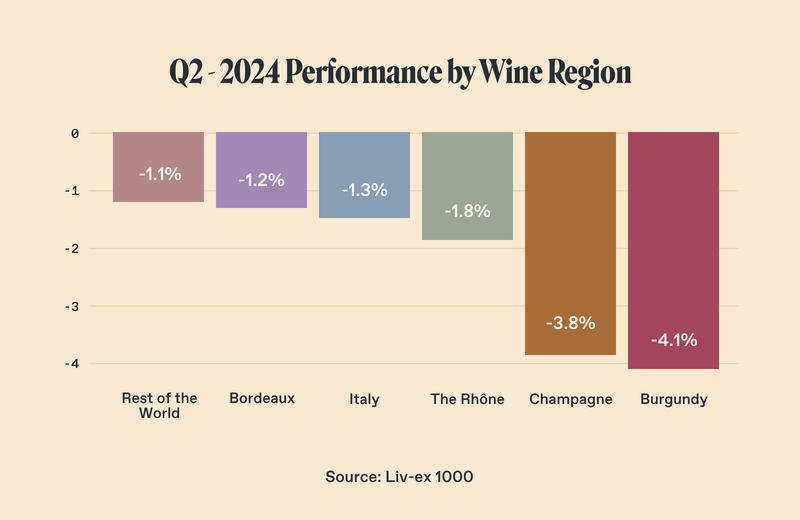
Zooming out, Italy ranked as the top-performing index of 2023. According to Liv-ex, it was the only index to record a single-digit drop in price compared to Bordeaux at -11.1%, Burgundy at -16.2%, and Champagne at -18.3%. Italy has benefited from sustained demand throughout the year, allowing prices to remain steady in the face of a market-wide price correction.
Within Italy, Piedmont stood head and shoulders above the rest of the industry. The northern wine region recorded a mere -0.1% decline in 2023. The 2001 Giacomo Conterno Monfortino Reserva led the way with a 40.1% return for the year, while Gaja Barbaresco notched four vintages (2010, 2015, 2011, and 2012) with double-digit gains. Vinovest winery relations manager Olivier Bouchard noted, “Top Piedmont producers are still in demand considering a tough market.”
The spin. The positive performance could be the momentum swing Vinovestors need going into the new year. Like any asset market, fine wine moves in cycles or long periods of gains followed by short pullbacks. The past year has been one of those normal and healthy pullbacks. As prices continue to stabilize, there’s reason to believe wine prices should rebound in 2024.
Top Performing Wines of the Year
High inflation continued to sting investors in 2023. Fortunately, several wines handily outpaced inflation. Bordeaux fared especially well, notching five of the ten best-performing wines of the year, including two entries apiece from Château Climens and Château Coutet.

The bigger news is Bordeaux’s market share. For the first time in a decade, Bordeaux’s share of regional trade by value is on the rise. Despite a lukewarm en primeur campaign, Bordeaux earned a 38% market share, its highest mark since 2020.
A couple of factors contributed to this rebound. First, Bordeaux has strong liquidity even compared to other top wine regions. In a down market, sellers are drawn to wines that can be more easily bought and sold.
Many also consider Bordeaux the safest, best-known market. In previous down markets, collectors have flocked to Bordeaux as a result. Collectors would be hard-pressed to find such consistent output quality at a certain price elsewhere.
Whiskey Performance
The new year is around the corner. If you have a whiskey cask in your portfolio, you should start it on a high note. Vinovest recently received its cask valuation for our 1-year-old whiskey holdings.
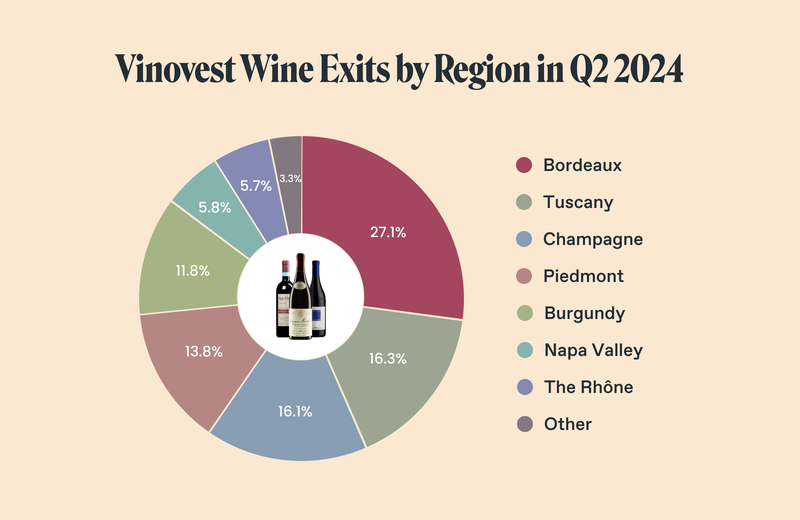
The Vinovest team is excited about these performances, though American single malt holds a special place in our hearts. The market supply for American single malt has been exceedingly tight.
Here’s why. In 2022, the Alcohol and Tobacco Tax and Trade Bureau (TTB) recognized American single malt whiskey as a new classification of distilled spirits. Before this, American producers were legally prohibited from calling anything “single malt whiskey” unless it came from Scotland.
Despite the legal change, only a few distilleries are actively making American single malt. The distillers who are "first to market" (re: our partners) will set the standard for high-quality aged American single malt.
Investing Outlook for Q1 2024
The wine market was defined by a “market correction” in 2023, with every wine index falling year to date.
A closer look suggests that fine wine prices are poised to rebound. We asked our in-house experts what they’re looking forward to in the new year. Here’s what they said.
On where to invest in 2024
Olivier Bouchard, Winery Relations Manager: “Grower Champagne seems like the obvious place to invest in 2024. They deliver comparable quality to blue-chip houses like Krug and Louis Roederer but at a fraction of the price. It should be a good year to diversify into these less famous houses.”
On the state of the wine market
Fabrice Georges, Winery Relations Manager: “Let’s be realistic. 2024 won’t be miraculous for the wine market like 2021 and 2022, but it will be the necessary period of stabilization after a harsh 2023 correction. I think 2024 will be the Year of the Collector with the lowest wine prices in years and more stability.”
Robbie Taylor, Head of Trading Asia Pacific & Global: “2023 proved to be a challenging year for the fine wine market, and 2024 will have its own unique challenges. However, there’s reason for optimism with potential economic growth in China, Bordeaux’s increased trade volume, and burgeoning demand for fine wine among Southeast Asia’s middle class.”

On Bordeaux
Georges: “It’s no secret that Bordeaux en primeurs and the beyond Bordeaux campaigns were disappointing. Many wineries should have gotten the message about overpricing their new wine in a tough market.”
Bouchard: “Top Bordeaux will continue to feed the market and take away market share from Burgundy. Even if Bordeaux doesn’t soar in price growth, the volume and liquidity of the region are unmatched. The real question is: can châteaux avoid another pricing mistake during en primeur? Fingers crossed that they do.”
On Burgundy
Georges: “If any wines will see prices drop, it will be high-end Burgundies. Speculation was rampant, and the market correction in 2023 was a healthy and necessary thing. The good news is that we should be close to the bottom.”
Bouchard: “I agree with Fabrice. A continued correction on highly speculative Burgundies like Bizot, Ente, and Arnoux Lachaux appears likely. That said, more qualitative and reasonably-priced domaines, including Trapet and Lignier, could rise in value to feed consumer appetite. Burgundy prices should increase again at the end of 2024 or early 2025.”
On Italy
Georges: “Italy is compelling. Top Piedmont producers are still in demand, considering a tough market. Meanwhile, Sassicaia should continue to perform well even if it’s not the most interesting Super Tuscan these days. I’d rather focus on Tignanello and Solaia, which are harder to source and have high liquidity in this market.”
Taylor: “It appears that Brunello, Barolo, and Barbaresco might see their day in the sun this year and are perhaps the regions to watch.”
On the Rest of the World
Bouchard: “Napa Valley prices should rise, thanks to strong demand in the US market. That alone can offset lower demand for its cult cabs in places like Asia.”
Bouchard: “South American wines might be in trouble in 2024. The last worldwide release through La Place in September fell flat because 1) the wine is not rare enough, 2) its relatively overpriced, and 3) demand for new wine is low. The fact that South American producers are still catching up to France and Italy in terms of reputation doesn’t help either.”
New American Whiskey Mashbills Coming in 2024
In 2024, Vinovest will make six different specialty mashbills available - three wheated and three rye whiskeys - each with profiles similar to some of the biggest brands in the industry. The new mashbills include:
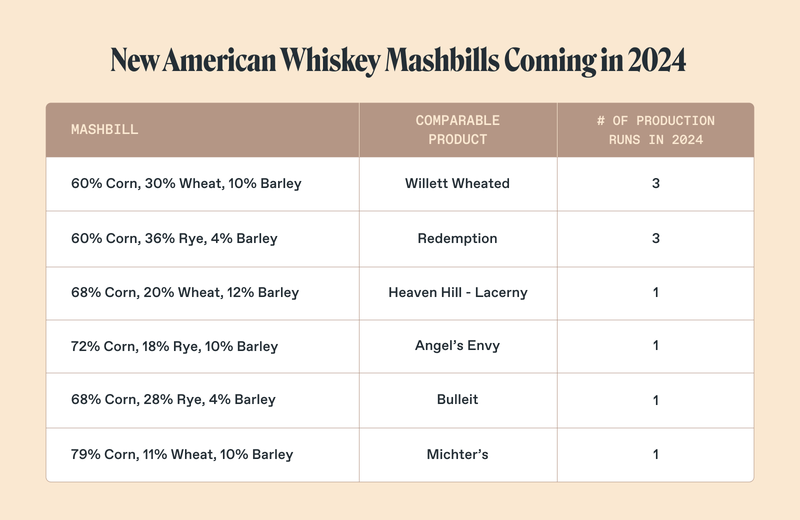
We’re especially excited about the wheated releases. The high price tag for wheat makes wheated bourbon scarce. Giants like Willet will use <20% wheat in their mashbills and charge $300 per bottle! Fortunately, you can get 40 bottles worth of whiskey for the same price with our newly-released whiskey lots.
The 7 Biggest Stories of Q4
1. Whiskey Lots Lower Minimum to $300
Vinovest was founded with one mission – to democratize wine and whiskey investing. In December, Vinovest took a huge leap forward with whiskey lots.
Normally, a cask of American whiskey costs $1,750. Our co-founders recognized that that was still out of the price range for many would-be whiskeyvestors. With whiskey lots, Vinovest has lowered the cost of investing to just $300.
So, what is a whiskey lot?
A whiskey lot is its own distinct unit of measurement - 8.67 gallons of whiskey, to be exact. Clients own their casked whiskey outright and do not share it with other clients. And here’s the best part. Whiskey lots share the same benefits as our standard American whiskey casks - portfolio diversification, a hedge against recessions and inflation, etc….
The only question left is: are you in good spirits?
2. Record-Breaking Whiskey Prices at Auction
Talk about a splurge.
The whisky industry has seen collectors pay eye-popping prices for rare whiskies. While we are tempted to devote an entire report to these staggering sums, here are the three most notable auction results to know.
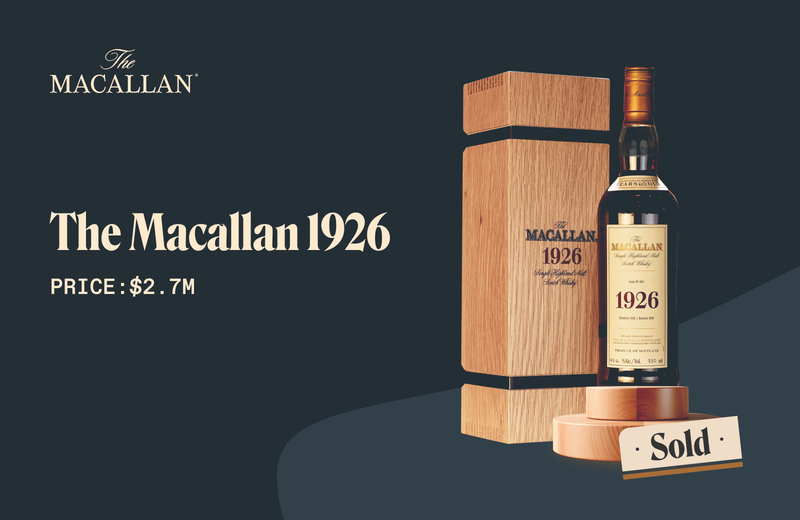
The Macallan 1926
At $2.7 million, this ultra-rare Scotch became the most expensive bottle of spirit or wine ever sold. That’s not all. It sold for almost three times the pre-sale estimate of $934,274 to $1.4 million. As Sotheby’s Global Head of Spirits, Jonny Fowle, later said, “This record-breaking result for The Macallan 1926 is nothing short of momentous for the whisky industry as a whole.”
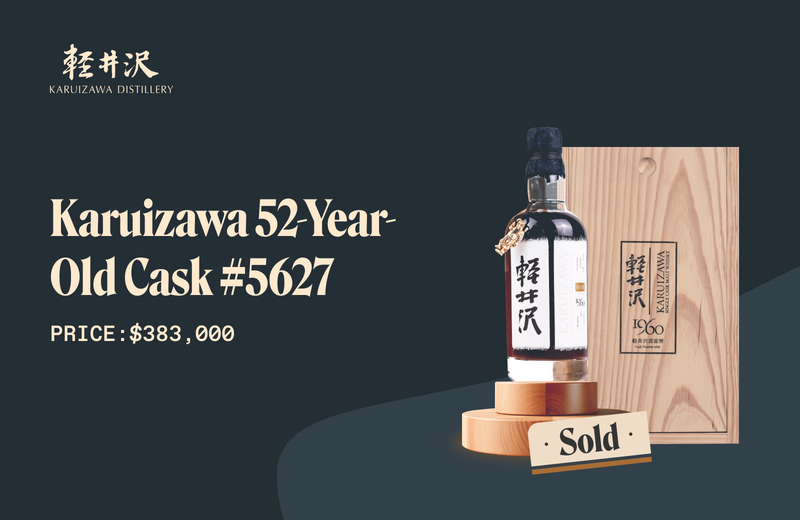
Karuizawa 52-Year-Old Cask #5627
In November, the Kodawari | The Greatest Japanese Whisky Collection garnered $2.3 million when it sold several single casks from the Karuizawa Distillery. The crown jewel was a 52-year-old whisky distilled in 1960, the oldest Karuizawa ever released and one of only 41 bottles made.
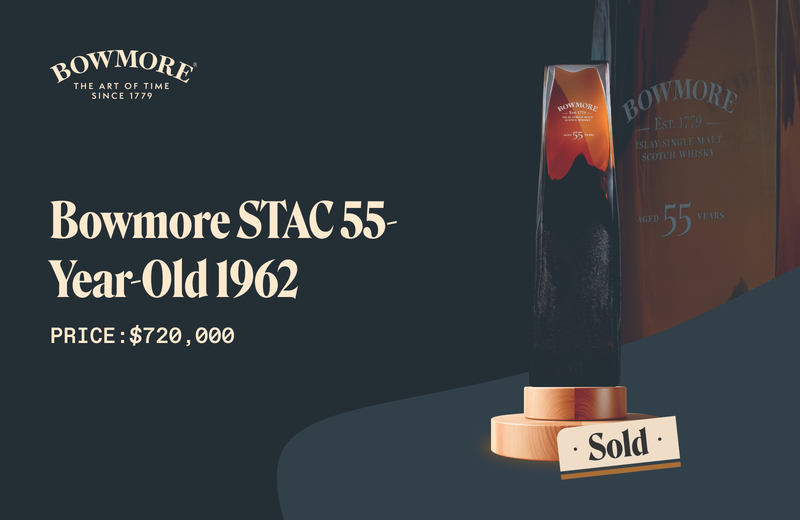
Bowmore STAC 55-Year-Old 1962
This single malt spent more than five decades in second-filled American oak hogsheads within the Bowmore’s No.1 Vaults. In October, it became the oldest Bowmore whisky ever sold. Those fortunate enough to sample the illusive elixir have reported notes of soft orchard fruit, honey, menthol, saline, and vanilla.
3. Rare Whisky Market Softens in Q4
While fine whiskies continue to set auction records, research suggests that the market for these select spirits may be softening. According to the corporate finance boutique Noble & Co., the value at whisky auctions has declined, even though the volume has increased by 10%. The findings suggest that inflation, among other outside pressures, is testing collectors’ willingness to buy the rarest and most expensive whiskies.
Of course, this phenomenon applies largely to the top 0.1% of whiskies (e.g., The Macallan, Highland Park, The Yamazaki.) While top-end whisky collectors are showing caution regarding price and value, general interest in whisky continues to grow in volume. The Noble & Co. report found that secondary whisky sales on bottles priced $126 and higher increased in volume by 17% this year while the value remained level. Meanwhile, the value of sales jumped 21% in 2022.
4. Napa Valley Completes Stunning 2023 Vintage

Wine lovers are in for a treat. The 2023 Napa harvest could not have gone much better.
Here’s what you need to know. Napa Valley experienced a long, cool summer in 2023. The winter saw ample rain, which ended a multi-year drought. Summer temperatures rarely hit 100 degrees and allowed vines to flourish. As the San Francisco Chronicle put it, “California wine harvest is off to the 'best start' in 50 years.”
As a result, grapes developed desirable characteristics like:
- Full flavors
- Perfect ripeness
- Low to moderate alcohol levels
It will be several months before these wines hit the open market. When they do, the 2023 vintages should reward palates and portfolios for many years to come.
5. Climate Change Boosts Wine Quality
Climate change is altering the world of fine wine, with everything from late frosts in France to smoke taint in Napa Valley. A new study suggests that it might not all be bad. A paper from the University of Oxford argues that climate change trends are likely contributing to improving wine quality.
The researchers used 70 years of data to find a relationship between critic scores and weather. They found that the highest-rated wines came from vintages with warmer temperatures, higher winter rainfall, and earlier growing seasons. All of these conditions are becoming more common with climate change.
There’s just one catch - droughts. As lead researcher Andrew Wood wrote, “The problem in scenarios where it gets really hot is water: if plants don’t have enough, they eventually fail, and when they fail, you lose everything.” Consider this a reminder that too much of a good thing is no good at all.
6. Champagne Shifts Toward Single Site Expressions
Champagne is synonymous with complex cuvées that blend grapes from multiple vineyards. Centuries of tradition might be approaching an inflection point, though. According to The Drinks Business, “the region is shifting its focus towards single site expressions and still wines.”
Climate change represents a catalyzing force. Unlike most prized wine regions, Champagne experiences cool temperatures that can slow ripening and leave grapes more acidic and less sugary. Rising temperatures may unlock the region’s ability to produce outstanding vintages with unique Champagnes from different terroirs.
This transformation would mark the “Burgundinasion of Champagne.” Instead of modeling itself after the big châteaux of Bordeaux, Champagne would have more in common with the terroir and village-oriented Burgundy. Considering that Burgundy is home to some of the most sought-after and investment-worthy wines, single-site wines could prove fruitful for Champagne collectors and consumers alike.
7. Vinovest Launches Beyond Bordeaux Collection
Great wine doesn’t just come from France. It can come from anywhere. That’s what La Place de Bordeaux is for - a system that the world’s top wineries use to release their best wine.
This year, Vinovest took people inside the normally closed-off action. We released ten La Place de Bordeaux wines on the Vinovest Marketplace, including:
- 2021 Clos Apalta
- 2021 Almaviva
- 2021 Tua Rita Redigaffi
- 2020 Solaia
- 2018 Opus One
The collection launched on Thursday, October 12. Within 48 hours, the top labels were all but gone. Fortunately, they’re not gone forever. You can still find bottles on the Vinovest Marketplace.
Photo of the Quarter
Just because Vinovest is remote doesn’t mean it has to stay remote.
In October, our CEO and co-founder Anthony Zhang hosted a wine tasting with some Vinovestors in Orange County. Attendees uncorked and learned about more than 15+ investment-grade wines all featured on La Place de Bordeaux. People had the option to bring a bottle from their own personal cellar, too, with the crowd favorite winning a set of hand-blown wine glasses.
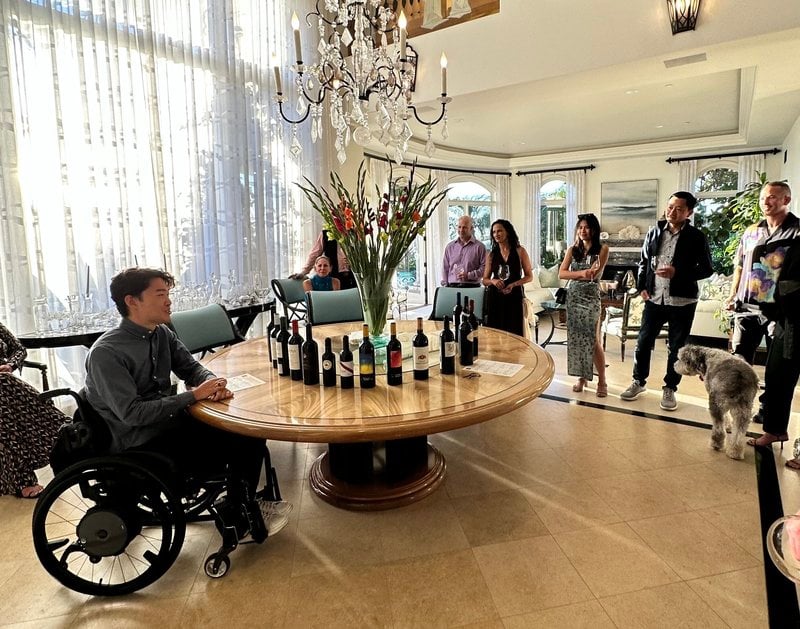
In Case You Missed It
The Vinovest team had a busy fourth quarter hosting webinars, talking with journalists, and even jumping on a few podcasts. Here are a couple of highlights.
Move Over, Stocks - Alternative Investing Apps Are Here - The Hustle, October 10
Stocks are cool. But have you tried wine and whiskey investing? The Hustle thinks you should. The business and tech site recommended Vinovest as one of the top apps for alternative investing. Cheers to that.
Whiskey Investing Aging Nicely - The Business Times, October 16
Bumpy times call for smooth measures. That’s why reporter Howie Lim of The Business Times called up Vinovest CEO and co-founder Anthony Zhang to talk about whiskey investing. With strong historical returns and bond-like stability, fine whiskey has proven to be an antidote to today’s economic volatility.
Vinovest Year-End Meeting, November 30
Every year, Vinovest hosts an annual year-end meeting where clients can ask questions, share ideas, and provide feedback directly to the Vinovest team. It’s also a chance to get a sneak peek of what’s in store in 2024. If you missed out, don’t worry. You can watch the entire thing in the Vinovest Community.
Episode 5: Wine Investing Holiday Special with Matt Parker and Anthony Zhang - Capital Decanted, December 19
Fine wine isn’t just for drinking. That’s what Capital Decanted listeners learned this December. CEO and co-founder Anthony Zhang guided listeners through the history of wine investing and the unique benefits of the asset class. Get your tour wherever you listen to podcasts.
